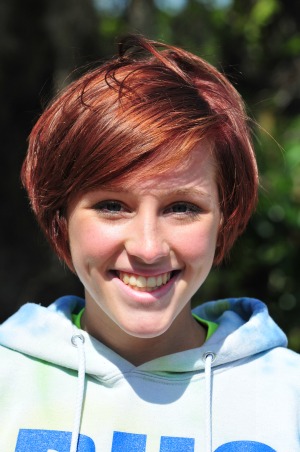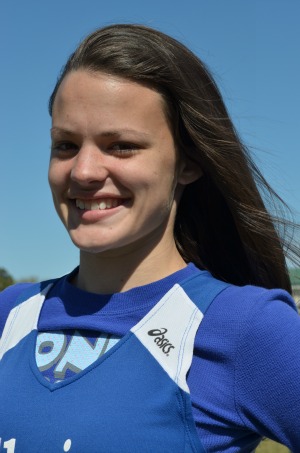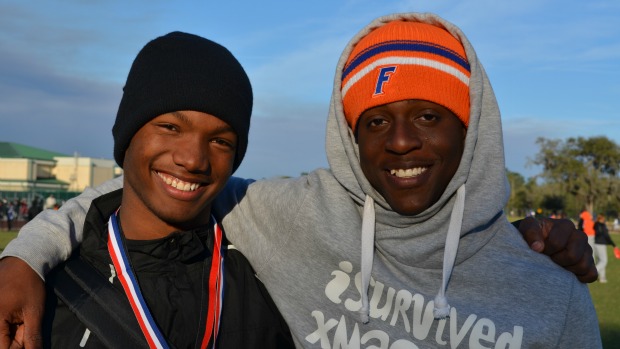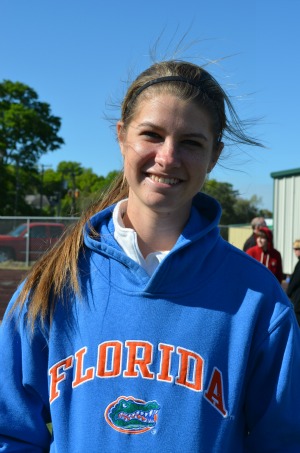
 It was one of those early season meets that most of us look forward to: a potentially fast-moving, all-relay schedule on a bright spring day, with the unspoken promise of good times to come. But when you stepped off the bus into that delightful DeLand sunshine, wham!--you got hit right in the face with a bone-chilling blast of arctic air. Although it was the second day of March, the BIG CHILL had come to the “Big D.”
It was one of those early season meets that most of us look forward to: a potentially fast-moving, all-relay schedule on a bright spring day, with the unspoken promise of good times to come. But when you stepped off the bus into that delightful DeLand sunshine, wham!--you got hit right in the face with a bone-chilling blast of arctic air. Although it was the second day of March, the BIG CHILL had come to the “Big D.”
Each year of high school, tracksters endure heat, humidity, hurricanes, sinkholes, snakes, tornadoes, tourists, wildfires, and even Walt Disney World’s version of track and field with silent resignation, so what’s a little cold weather? In preparation, out came the double sweats, blankets, ski hats, scarves, long-ignored girlfriends, or—as a last resort--good old Mom to add a little warmth in between “heats.” Brightly-patterned polar fleece that dotted the infield became an unofficial team uniform in itself, which seemed to draw friends and family to them like an AT&T discount.
If it wasn’t cold enough already, the wind--which first began to pick up at around 11 AM, and grew steadily stronger as the meet progressed--shortened every airborne effort, made each lap a few steps longer, and assured all of us that we definitely didn’t want to relocate to Fargo anytime soon. Leaves and twigs swirled, empty coffee cups bounced along the ground, and straw hats flew off into the distance. The gusty blasts tipped over crossbars and hurdles, flattened tents and times, and carried away chairs and small children.
All in all, it wasn’t long before the infield became a frenetic mob of heat-seeking humanity. The one good thing in all this was that not a single coach had to remind one of his athletes to warm up before his race.
Amidst all this were those few, truly intuitive athletes--like Kelsey Klein of Mainland--who sat smug in her preparedness.
“Where does someone from Florida have the foresight to purchase a hat like that in the event of a day like this?” I asked her.
“I got it at Hallmark, for like $2,” she said, smiling. “I bought it a year or two ago. It was totally worth it.”

(For those who are not from a place where this type of headgear is standard March wear, it is called a Sherpa, with ergonomically designed earflaps to prevent frostbite, and a flexible speedball on top to reflect your forward velocity.)
Around and Around We Go
From a personal standpoint, I quickly get disoriented in a meet made up entirely of relays. It isn’t the relay itself that does it, but the cumulative effect of, say, a varsity 4 X 1 (won by the Mainland boys in 41.97, and the Buchholz girls—heat two, no less--in 50.37), then a Freshman/Sophomore 4 X 1 (both won by Ocala Vanguard; the boys in 45.04, and the girls in 52.93), and at last the weight throwers 4 X 1 (Mainland boys in 48.69 and Seabreeze girls—heat two--in 57.7). See what I mean? Throw in a sprint medley 800 (100-100-200-400; Seabreeze boys—heat 2--in 1:36.87 and Sanford Seminole girls in 1:56.16) and then a sprint medley 1600 (200-200-400-800; Orange City boys in 3:50.32 and the Sanford-Seminole girls in 4:47.32), and I find myself eagerly interviewing shot putters who seem more like distance runners.
 Ralph: “You look like a cross country runner.”
Ralph: “You look like a cross country runner.”
Penny Gonnsen: “I am.”
Ralph: “How did you end up throwing the shot?”
Penny: “I was thinking of doing it at the beginning of the season, but this is my first meet. My goal is not to scratch.”
Ralph: “You mean foul.”
Penny: “Yes, foul…whatever.”
While runners ran in fours, event “teams” were scored by adding up their top three distances/heights. Penny, a sophomore at Belleview High School, threw 14’ 6”, and her team’s top three throwers’ total was 73’, which landed them in the happy half of the relay results in the shot put (sixth of 13). Led by senior Ellexie Haughton, Ocala Forest went 1-3-7 to win the event with 97’ 1”.
Team scores were not kept—at least officially—but the contributions of Penny’s teammate Liz Woodward went a long way towards making Belleview one of the obvious leaders among the girls teams. (They had three firsts, two seconds, and two thirds among their final tally.) Tracy herself won the high jump (5’7”), was a leg in Belleview’s second place shuttle hurdle team (1:08.44, behind Spruce Creek’s 1:08-flat), long jumped 15’ 10” (Belleview was a team fourth), and triple jumped 28’ 10” (Belleview was third).
I caught up to her after her win in the high jump.
“I was sooo close to 5’ 9” that it was excruciating,” she said. “I guess I should have come in at 5’ 2”, instead of 5’, or skipped 5’ 4”. There was a little bit of fatigue, but not much.”
“A little bit of fatigue” is understandable. Not only did Woodward score in four events, but she had one personal best (the TJ), tied another (16.22 in the hurdles, unofficially), and netted two season bests (her HJ PR of 5’ 8-1/2”was set at the 12/15/12 NTC TCF 2012 Challenge 2, and her LJ PR of 16’ 1-3/4” at the Lecanto Panther Invitational on 2/21/12).
“That was only my second triple jump. I did it my sophomore year, so I think it threw me off a little.”
And then there was the wind, bane to all jumper-uppers.
 “Sometimes, when I went to jump, it would interfere.”
“Sometimes, when I went to jump, it would interfere.”
The probable chemistry major is currently “looking at recruitment opportunities at USF and the University of South Alabama,” or perhaps, I might add, a college track team that needs a heptathlete?
“No way. There’s the 800,” she countered.
Back to the relays: Belleview’s gals won the DMR in 13:31.70, the 4 X 8 in 10:09.04, and the high jump in 14’ 0”. Their male counterparts were Deland in the DMR (11:27.55), Spruce Creek in the 4 X 8 (8:31.28), and Sanford-Seminole in the high jump (17’ 6”).
Seminole took one-two in the latter, with Farrin Brownlee (6’ 4”) and Qvon Fayson (6’ 2”) both going to extraordinary heights to do so. It wasn’t easy, as each underscored an obstacle, in addition to that of gravity.
Farrin: “The light; jumping right into the light,” referring to the setting sun being strategically located just above and beyond the crossbar.
Qvon: “The wind; it was gusting.”
I mentioned the fact that, contrary to standardized track regulations, high jump areas differ from track to track.
Q: “Here, the apron was very short. We had to go out to the grass.”
And yet, their performances seem to be quite consistent. Both replicated—exactly—PRs that were set exactly one week earlier at the Highlander Invitational, and with results being the exact same order of finish.
Farrin: “It’s something that I try to do every week, I guess, trying to get a gold medal two weeks in a row. I also PRd at Lake Highland Prep last week.
Q: “My PR was 6’ 2” at Lake Highland.”
Farrin: “We practice (doing the same things) every day, like we do in a meet. We try to bring it (the bar) up every day, and keep our form.”

Q: “Same thing; approaches, and flexibility over the bar.”
Farrin: “I’ll stretch three times, and think of clearing the bar. Then I’ll run and jump. But when they raise the bar, I won’t look at them doing it.”
Q: “I’ll walk up to it, and mentally prepare to jump it. Then I’ll walk back, say a prayer, and go for it.”
Farrin: “Our teammates always motivate us to PR every week.”
Q: “Coach Brauman taught us to ‘never give up the ghost.’”
More relays: In the 4 X 2, Mainland’s boys won in 1:29.91, and the Buchholz girls—from heat two—in 1:47.94; Mainland also won the “mixed” (boys and girls)—heat 2--in 48.69; and in the 4 X 4 Orange City won for the boys (3:31.48) and Spruce Creek for the girls (4:08.55).
Spruce Creek was particularly strong in the field events, and the only team to double in any event—boys and girls--twice. (A double-double.) Plus they also doubled in the boys weights (a triple double?).
Creek’s Keith Narozney tied for the longest throw with Forest’s Paul Preston in the shot (46’ 1-1/2”) before going on to win again in the discus (141’ 11”). Along with Rodney Mack (fourth in both throws; 41’ 10-1/2” in the shot and 134’ 2” in the discus) and Brandon Ditton (his 140’ 6” was third in the discus and 41’ 10-1/2” ninth in the shot), their team swept the team weight events.
Keith is a young man of mammoth throws, yet few words. As spokesmen, SC has Rodney and Brandon.
Rodney: “The weather killed us, but we pulled through.”
Brandon: “A cold disc hurts the throw.”
Rodney: “We’ve been throwing much better when it was warmer and we were loose.”
Brandon: “The only disadvantage to warm weather is that your hands are slippery.”
Rodney: “In the cold weather….”
Brandon: “There’s a better grip,” continued Brandon, finishing the thought. “The wind was a factor in the shot, too. It was coming across at you.”
Rodney: “Luckily, we’re all close together and can push each other.”
Brandon: “I definitely think we’ll do some damage in the Districts and Regionals.”
 10th grader Kristen Gaines won the Girls’ Pole Vault for the second year in a row (8’6”), and, despite the wind, senior Kolby Davis tied his 13’ PR in winning the Boys’.
10th grader Kristen Gaines won the Girls’ Pole Vault for the second year in a row (8’6”), and, despite the wind, senior Kolby Davis tied his 13’ PR in winning the Boys’.
“I came into the season at 12-6,” Davis said after his last jump. “I have gone 13, but haven’t hit it in a long time. (Today) I just concentrated on my jump, and not the obstacles. I just try to focus on the perfection of my jump. I don’t blame my mess-ups on anything but myself.
“I want to win States. I honestly don’t know what height that will be—maybe 14-6—but it will definitely be with a bigger pole. I’ve only been on a 155 for one day—today—and already had to transition into a bigger pole after jumping.”
Kolby, incidentally, has his mind set on becoming a fire fighter, an interesting thought in and of itself. Out west, there is a certain niche for fire fighters who also like to jump--from planes--and land in the midst of wildfires. Sound dangerous enough for you, Kolby?
While we could definitely see and smell the smoke from the I-95 brushfire throughout the meet, it didn’t seem to influence another Spruce Creek senior, Rachel Wofford, to join her track teammate on the fire truck.
“I’m actually committed to Yale,” she told me. “I visited there in November. Hopefully, I’m going to major in chemistry and pursue a graduate degree in pharmacy at UF.”
But first, she has one last season to fulfill another ambition.
“I’ve never made it to the State Meet. It would be my ultimate goal to make it there and perform well.”
 At this point, Rachel has two possibilities, as she proved in winning both the long jump (17’ 0”) and the triple jump (35’ 5”).
At this point, Rachel has two possibilities, as she proved in winning both the long jump (17’ 0”) and the triple jump (35’ 5”).
“The long jump is ‘around’ what I’ve been jumping all season, but my best is 18 feet,”--she set her PR of 18’ 3-1/4” at last year’s 4A District 2 Meet, on April 12th--“and I need to pick up my triple jump a little. I’m really happy with how things are going with the triple jump. I’ve really improved over where I was last year. I believe I jumped 34 feet at this meet last year.”
Rachel was also in a third event.
“Today, I ran in the shuttle hurdle relay. I really like the hurdles. It’s enjoyable, and there’s not a lot of pressure. It’s actually my first year of running them. He (Coach Gallon) thought I’d be decent at it, and this is the third meet that I’ve run it.”
Rachel found the windy conditions more of a problem on the hurdles than the jumps, perhaps because the girls’ jumps runway is more or less sheltered by a fence where the vegetation has grown along and through it.
“For the long and triple jump, it was relatively calm. But for the hurdles, I had a tail wind, which pressed me towards the hurdles. I felt like I had to slow down a little. We ended up getting third with our “B” team.”
As previously mentioned, Spruce Creek’s “A” team won that event with a 1:08. So her supporting role on the meet’s third best team is overshadowed by her leading the meet’s very best long jump and triple jump teams (SC’s team totals: 47’ 9” in the LJ, and 110’ 6” in the TJ). In that long jump, Sanford-Seminole’s Ravyn Mike also jumped 17’ 0”, tying Wofford for place and distance.
On the boys’ side, SS freshman Christoher Holiday leaped halfway into the spectator area (a 20’ 2” PR) to win the LJ, then added a 39’ 9-1/2” triple jump. Behind him, there were two 19’ long jumps (SC’s Jeff Spence at 19’ 11” and Buchholz’s Mike Tillman at 19’9”), but Seabreeze placed fourth through sixth to win the team title. Their jumpers were Josh Stevens (19’ 6”), Justin Sampson (19’ 3”), and Cole Dunagan (18’ 11”).
Spruce Creek “got the jump” on the competition in the TJ, as the Brothers McMillon, junior Tadarius and sophomore Tremell, jumped 42’ 4” and 42’ 1-1/2” respectively. A 38’ 1” jump by Garek Church brought them over the line (122’6-1/2”) and they won with the highest team total.
In the two girls’ weight events, Allexie Haughton swapped wins with Forest teammate Rachel Lightsey—the former had 34’ 7” in the shot and the latter 99’ 1” in the discus—respectively, and their team won both titles. Ellexie also took 11th in the discus (73’ 2”), and Rachel third in the shot put (30’ 1-1/2”). Joining their medal count was Mariana Mustain (2nd with a 98’ 1” DT and 3rd with a 32’4-1/2” SP).
In amongst all these relays, two individuals stood out, one by virtue of consistently outrunning his competition in the middle distance races, and the other by adding a “second wind” to the day’s already blustery results.
 Keneth Pineiro, the reigning Distance King of Volusia County, is definitely a barometer of events in and around his domain.
Keneth Pineiro, the reigning Distance King of Volusia County, is definitely a barometer of events in and around his domain.
“I just have the worst luck,” he confided in me. “I finally got ‘in the zone’ and Whup! I got injured. First it was my grades”—last spring he had a ‘minor thing’ with one of his IB classes, causing him to miss the post-season—“then Whup! A pothole this past December.”
There have been other things, but why belabor the point? Out west it’s called “being snakebit,” in track it’s called “sidelined.”
“I was terrified when I went to the Embry Riddle Running Camp”—in the mountains of South Carolina, last summer—“but once I got used to it, I felt comfortable running trails. It really helped me break 16.”
Keneth lowered his 5K time to 15:34.93 at the 4A Region 1 Meet this past November 9th, but the following week caught the flu, and decided to gut it out at the State Meet. He survived, but ran a disappointing 16:47.38. Like I said, snakebit. (Tallahassee is west of DeLand, isn’t it?)
“Breaking 16…it was really, really big, and it did a lot to build my confidence. Now I run a much quicker pace.”
But then came that injury, incurred on a trail near his Deltona home—Keneth lives in Deltona, but because he is an IB student, attends school in DeLand—an unexpected coaching change, and, well…he remains optimistic.
“My first goal is to beat my PR in the 1600, which is 4:25 (.37, set at the April 8, 2012 5 Star Conference Championship). I do want to race the 3200 (his PR is 9:46.09 at the Deltona Invitational, on March 16, 2012), but I don’t have any goals for that at this time.”
Lately, due to the ankle problem, he has been running mostly 800s, more or less to keep the racing mileage at a minimum.
“I also want to break 2:00 in the 800”—his best is a winning 2:01.07 at the March 22, 2013 East Coast Classic—“and I’m working on it. I’m just following (Coach) Lowe’s training, and running in every meet.”
Although in this meet he ran in three races—the 4 X 8, the 1600, and the DMR—his times were “off” a little, but plenty good enough to dominate. He ran 4:37 and 4:39 in his two 1600s, but everyone somehow forgot to start their watches in the 800.
“The wind was like hitting a brick wall in that straightaway. It was both a race against the conditions, and the competitors. You want to do well in a sense that I don’t expect to go easy in order to win; I just do the best that I can in every race.”
Although you see it listed in most meets, the “Adaptive” events have few takers. Possibly equipment is an issue? Google it and you’ll find that a decent racing chair costs three grand—the disk wheels run $1700 a pair—a price that makes a $100 pair of training shoes a comparative bargain. And a successful outcome in a wheelchair race is probably 90% chair, and 10% training. Plus, and this is a big ‘un, getting up a good head of steam against the wind is part of the battle. But once you do, hold on tight, ‘cause that chariot can fly--but it can also flip over backwards with the slightest shift in weight. Some of the best ones weigh as little as 14 pounds, far less than the athlete sitting in it. (They are designed for people who can weigh as much as 250 pounds.)
The payoff on all of that--$ chair + serious weight training + endless hours of hand-crank training + total commitment—can get you a 1:18:25 WR in the marathon (Joshua Cassidy, of Toronto, Canada, in the 2012 Boston Marathon). That, remember, is on roads. Compare his time to that of AB runner Patrick Makau of Kenya: 2:03:38 on September 25, 2011 in the Berlin Marathon, and you might think: “Where do I sign up?” Before you do so, first consider that you’d be “running” 26.2 miles with your arms. (Measure the size of a serious wheelchair athlete’s arms with that of your favorite runner.)
Watching Ocala-Vanguard’s Joey Gibbs struggle, first against the wind, then the incredibly near-impossible feat to beat the friction of DeLand’s worn-out, rubberized track (Holy bike-brakes, Batman!) and you’ll begin to understand that his race wasn’t simply against the clock. It was a battle of his tires trying to maintain momentum against all those ground-up automobile tires that are now the track. (Tire-on-tire.)
“It’s a rental,” Joey said of his chair. “I’m borrowing it from a couple, Pam and Randy. They get them and have people call them for rentals.
“The first time I used it was in December, for about two races. My first race was at Forest, at a track in February. My time was 42.67.”—for 200 meters—“The most difficult thing about it is the wind. As you saw, I did absolutely horrible. (52.70)
“I’m doing the 800 too. My first time in that was 2:46. I find the 200 easier, but the wind will be hard there too.
“I want to get through the middle of the year and see what happens.”
In his second, wind-battered race, Joey finished in 3:30.82. But perhaps finished is too fatalistic a word. In terms of wheelchair racing, there is always a beginning, then a test of resolve, and finally that moment of decision: do I commit myself to doing this with all my heart, or do I not? Having covered and commented on disabled athletes since the 1984 World Games for the Disabled (East Meadow, New York), I have found that the truly dedicated athletes among them rarely accept failure as a permanent disability. At some point in the near future, Vanguard’s Joey Gibbs will find himself at that windy crossroads where he has to choose between two directions; what might be considered the “easy road,” or the one far less traveled, but infinitely more satisfying.
More Coverage
- Complete Results & Coverage
- Photo Album by Ralph Epifanio (1291 Photos!)